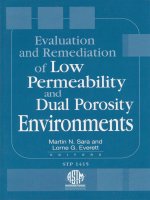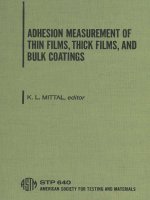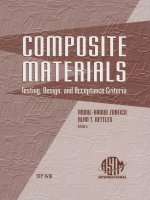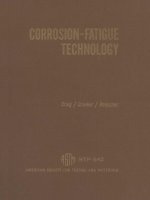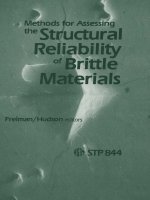Astm stp 936 1987
Bạn đang xem bản rút gọn của tài liệu. Xem và tải ngay bản đầy đủ của tài liệu tại đây (5.54 MB, 384 trang )
INSTRUMENTED IMPACT
TESTING OF PLASTICS
AND COMPOSITE
MATERIALS
A symposium
sponsored by
ASTM Committee D-20
on Plastics
Houston, TX, 11-12 March 1985
ASTM SPECIAL TECHNICAL PUBLICATION 936
Sandra L. Kessler, PPG Industries, Inc.
G. C. Adams, E. I. du Pont de Nemours & Co.
Stephen Burke Driscoll, University of Lowell
Donald R. Ireland, Ireland and Associates
editors
ASTM Publication Code Number (PCN)
04-936000-19
1916 Race Street, Philadelphia, PA 19103
#
Copyright by ASTM Int'l (all rights reserved); Thu Dec 31 17:01:19 EST 2015
Downloaded/printed by
University of Washington (University of Washington) pursuant to License Agreement. No further reproductions authorized.
Library of Congress Cataloging-in-Publication Data
Instrumented impact testing of plastics and composite
materials.
(ASTM special technical publication; 936)
"ASTM publication code number (PCN) 04-936000-19."
Includes bibliographies and index.
1. Plastics—Impact testing—Congresses. 2. Composite
materials—Impact testing—Congresses. I. Kessler,
Sandra L.; Adams, G. C ; Driscoll, Stephen Burke;
Ireland, Donald R. II. ASTM Committee D-20 on Plastics.
III. Series.
TA455.P5I495 1987
620.1'9235
86-28692
ISBN 0-8031-0937-7
Copyright © by A M E R I C A N S O C I E T Y F O R T E S T I N G AND M A T E R I A L S
1986
Library of Congress Catalog Card Number: 86-28692
NOTE
The Society is not responsible, as a body,
for the statements and opinions
advanced in this publication.
Primed in Baltimore. MD
January 1987
Copyright by ASTM Int'l (all rights reserved); Thu Dec 31 17:01:19 EST 2015
Downloaded/printed by
University of Washington (University of Washington) pursuant to License Agreement. No further reproductions authorized.
Foreword
The symposium on Instrumented Impact Testing of Plastics and Composite Materials was held 11-12 March 1985 in Houston, Texas. ASTM Committee D-20 on Plastics was sponsor of the event. The symposium chairman was
Sandra L. Kessler, PPG Industries, Inc., who also served as editor of this
publication. Also serving as editors were G. C. Adams, E. I. du Pont de Nemours and Co., Stephen Burke Driscoll, University of Lowell, and Donald R.
Ireland, Ireland and Associates.
Copyright by ASTM Int'l (all rights reserved); Thu Dec 31 17:01:19 EST 2015
Downloaded/printed by
University of Washington (University of Washington) pursuant to License Agreement. No further reproductions authorized.
Related
ASTM Publications
Quality Assurance of Polymer Materials and Products, STP 846 (1985),
04-846000-19
Physical Testing of Plastics, STP 736 (1981), 04-736000-19
Wear Tests for Plastics: Selection and Use, STP 701 (1980), 04-701000-19
Copyright by ASTM Int'l (all rights reserved); Thu Dec 31 17:01:19 EST 2015
Downloaded/printed by
University of Washington (University of Washington) pursuant to License Agreement. No further reproductions authorized.
A Note of Appreciation
to Reviewers
The quality of the papers that appear in this publication reflects not only
the obvious efforts of the authors but also the unheralded, though essential,
work of the reviewers. On behalf of ASTM we acknowledge with appreciation
their dedication to high professional standards and their sacrifice of time and
effort.
ASTM Committee on Publications
Copyright by ASTM Int'l (all rights reserved); Thu Dec 31 17:01:19 EST 2015
Downloaded/printed by
University of Washington (University of Washington) pursuant to License Agreement. No further reproductions
ASTM Editorial Staff
Helen P. Mahy
Janet R. Schroeder
Kathleen A. Greene
William T. Benzing
Copyright by ASTM Int'l (all rights reserved); Thu Dec 31 17:01:19 EST 2015
Downloaded/printed by
University of Washington (University of Washington) pursuant to License Agreement. No further reproductions authorize
Contents
Overview
METHODOLOGY FOR IMPACT TESTING
Instrumented Impact Test Data Interpretation—
MATTHEW C. CHERESH AND STEVEN McMICHAEL
9
Methodology for Selecting Impact Tests of Composite Materials in
Automotive Applications—JAMES L. ROCHE AND
S. NORM K A K A R A L A
24
Instrumented Dart Impact Evaluation of Some Automotive Plastics
and Composites—CHARLES W. KNAKAL AND
DONALD R. IRELAND
44
Evaluation of a Variable-Speed Impact Tester for Analysis of Impact
Behavior of Plastics and Composites—M. R. KAMAL, Q. SAMAK,
J. PRO V A N , AND VAGAR AHMAD
58
81
Digital Filtering of Impact Data—PATRICK I. CAIN
IMPACT TESTING FOR END-USE APPLICATIONS
Impact Measurements on Low-Pressure Thermoplastic Structural
Foam—RICHARD C. PROGELHOF
105
Testing, Simulation, and Interpretation of Materials Impact
Characteristics—WARTAN A. JEMIAN, BOR Z. IANG, AND
lYH S. CHOU
117
Experimental Comparison of Several Impact Test Methods—
S. NORM KAKARALA AND JAMES L. ROCHE
Copyright
Downloaded/printed
University
by
144
ASTM
Int'l
by
of
Washington
(Unive
Variable-Rate Impact Testing of Polymeric Materials—A Review—
STEPHEN BURKE DRISCOLL
163
Prediction of End-Use Impact Resistance of Composites—
JAMES S. PERARO
187
IMPACT CHARACTERIZATION OF SELECTED MATERIALS
Instrumented Impact Testing of Aramid-Reinforced Composite
Materials—MARILYN W. WARDLE AND GEORGE E. ZAHR
219
Effects of Test Rate and Temperature on Fracture Behavior of Some
Rubber-Modified Polymers—SATISH K. GAGGAR
236
Impact Characterization of New Composite Materials—LEE W. GAUSE
AND LEONARD I. BUCKLEY
248
Flexed-Plate Impact Testing of Polyether Sulphone: Development of
a Notched Specimen—STAN TURNER AND PETER E. REED
262
PARTIAL IMPACT TESTING AND FATIGUE RESPONSE OF PLASTICS
Impact Fatigue of Polymers Using an Instrumented Drop Tower
Device—GEORGE C. ADAMS
281
Impact Response of Polymeric Materials at Varying Depths of
Penetration—w. M. LEE, WILLIAM W. PREDEBON, AND
MICHAEL L. JUROSEK
302
Assessment of Impact Characteristics for Incipient Crack Formation
in Polymeric Materials—w. M. LEE AND J. K. RIEKE
324
FRACTURE TOUGHNESS
Analysis of Force and Energy Measurements in Impact Testing—
JOHN M. H O D G K I N S O N AND J. GORDON WILLIAMS
337
Effect of Loading Rate on the Impact Fracture Toughness of Acetal
and Polymethyl Methacrylate—ROGER D. GOOLSBY AND
C H U N L I A N G LIN
Copyright
Downloaded/printed
University
351
by
by
of
INDEXES
Author Index
371
Subject Index
373
Copyright
Downloaded/printed
University
by
by
of
STP936-EB/Jan. 1986
Overview
The last two decades have witnessed an explosion in the use of polymeric
materials and their composites for structural applications. This has resulted
in more demanding acceptance criteria with respect to all mechanical and
chemical properties of these materials. In addition to the usual static properties obtained at very low testing speeds, it has become essential to know how
polymeric systems behave under dynamic loading conditions, such as highspeed impact. Examples of such applications for these versatile materials are
now commonplace: bumper backup beams, leaf springs, oil pan assemblies,
car body panels, equipment container cases, gasoline tanks, helicopter
blades, radiator shrouds, and other applications. In each instance the success
of the material in the application requires knowledge of its mechanical and
chemical property profile and, in particular, characterization of its impact
performance. This Special Technical Publication has been published as a
result of the 1985 symposium on Instrumented Impact Testing of Plastics and
Composite Materials, held in Houston, Texas, in an effort to communicate
state-of-the-art technology to those actively engaged in these studies. The
symposium was the outgrowth of work within ASTM Subcommittee
D20.10.02 on Impact and High-Speed Properties, a subcommittee of ASTM
Committee D-20 on Plastics.
It is well known to those involved in impact testing that there frequently
appear to be more variables than constants available to the engineer. The
engineer is required to make the right choices to characterize the material
properly for its ultimate use. It is generally true that an impact event can be
thought of as the contact of a high-speed projectile [velocity > 203 m (8000
in.)/min] of some specified geometry with a supported test specimen. During
this impact event the specimen absorbs and transmits energy that can be expressed in simplest terms as the integral of the force-displacement curve. The
shape of the curve provides information on the initiation, yielding, and propagation of energy during the event. The choices for the actual test configuration can be extremely diverse: the specimen may be notched or unnotched,
may be supported as a cantilever or flexural beam, and may be a flat plaque,
a rectangular bar, or the fabricated component. The striker (or tup) may be
driven or free-falling, and the test data may be instrumented or noninstrumented. Consideration of the inertial effects of equipment may or may not be
required. The engineer may be more interested in characterizing the impact
fatique life of the material, using low-blow impacts at energies less than that
Copyright
by
ASTM
Downloaded/printed
by
Copyright 1986 A S T M International
University
of
Washington
Int'l
(all
rights
reserved);
Th
www.astm-org
(University
of
Washington)
pursua
2
INSTRUMENTED IMPACT TESTING OF PLASTICS AND COMPOSITES
required for failure. Whether the material becomes work-toughened or fails
catastrophically after a particular number of impacts can then be determined. This can then provide insight into the useful life of a material under
certain expected conditions.
In order to define the proper test configuration for a material and application, the stress states and likely conditions need to be identified. What constitutes failure, the mode of failure, and its likely cause need to be established.
This provides the guidance necessary to determine what combination of tests
is required and what environmental conditions need to be considered. In the
development of materials for new applications, instrumentation of the impact
event is essential so that changes in the mechanism of failure can be quantified. Instrumentation provides data on the effective dynamic modulus of the
material under the conditions of test, its strain and elongation capacities, and
its energy storage capability. If no instrumentation is applied, a single number is obtained, which confounds these property values and does not provide
the engineer with information for modifying the material and measuring exactly how that modification has affected the impact trace or force-displacement curve. In addition, instrumentation allows the engineer to define conditions of failure that do not require destruction of the component. For
instance, a performance standard for a high-speed gear assembly could limit
the strain to less than 0.5% at a ram energy of 11.3 N • m (100 in. • lb), although the part may actually yield or break only at a much higher energy
level.
The collection of 19 papers published in this volume has been grouped into
five major categories. Some papers could be placed in more than one category, and here an arbitrary selection has been made. These categories are
methodology, impact testing for end-use applications, impact characterization of selected materials, partial impact testing and fatigue response of plastics, and fracture toughness.
Methodology for Impact Testing
The papers in the section on methodology are written with varying levels of
technical depth, which provides those relatively new to the technology with
specific guidelines for preparing the system for data collection, as well as evaluation of the data collected. In at least one paper the information is generic in
nature and is independent of the specific type of data system, test geometry,
and material tested. The differences between drop-weight machines and servohydraulic systems are also discussed. In this section the methodology for
selecting impact tests applicable for automotive composites and interpreting
their data is presented in detail. The approach that has been taken would be
suitable for any application and consists of four basic steps: establishing the
functional requirements for an application (a composite fender, for example), listing the stress states that could occur for the range of impact condi-
Copyright by ASTM Int'l (all rights reserved); Thu Dec 31 17:01:19 EST 2015
Downloaded/printed by
University of Washington (University of Washington) pursuant to License Agreement. No further reproductions authorized.
OVERVIEW
tions for each functional requirement, determining the controlling variables
for each stress state, and listing the failure limits for each functional requirement. It is often the case that several impact configurations and test conditions are required to test a material for a given end use. Also included in this
section is an analysis of the stability and reproducibility of a driven ram impact tester and recommendations on improving the reliability of the data. The
issue of changing velocity of the impact ram and its implications on the test
data collected have been addressed. Digital filtering has also been reviewed in
this section, with guidance provided as to its valid use and its misuse, which
leads to anomalous data and incorrect analysis.
Impact Testing for End-Use Applications
The section on impact testing for end-use applications is, by its title, of a
more applied nature and demonstrates the techniques used for various end
uses. Those specifically reviewed in this section are impact measurements on
low-pressure thermoplastic foam, material impact characteristics in the use
of cushioning systems, a detailed survey of ten test methods for characterizing
materials for automotive components, and impact testing for a variety of
products such as tires, reinforced thermosetting pipe, boat hulls, and baseball helmets. In this section the effects of strain rate and temperature on the
relative brittleness/ductility of materials is discussed, as well as the influence
of the thickness and cross-sectional uniformity of the material. In the case of
the survey of ten impact tests, conclusions regarding the relative discrimination powers of the tests, in comparison with each other, and their correlation
or lack of correlation with each other are presented. The paper on cushioning
systems presents a technique for quantifying the damping capacity of materials by the use of instrumentation of the impact event, which can discriminate
between recoverable, elastic deformation and permanent, nonrecoverable deformation.
Impact Characterization of Selected Materials
The third section, on impact characterization of selected materials, covers
more of the fundamental, research-oriented characterization of materials. As
described in the paper on polyether sulfone, an effort was made to effect material failure by machining a central hole 1 mm in diameter in the flat plates,
which were subsequently impacted by a falling dart. This work was done since
the material would not fail under no-notch conditions. This preliminary work
pointed to a brittle-ductile transition that was influenced by the presence of
the machined hole, but only within a defined thickness range. Another interesting study was reported on the influence of test rate and temperature on the
fracture behavior of rubber-modified acrylonitrile-butadiene-styrene (ABS)
and polyvinyl chloride (PVC), with particular emphasis on the location of the
Copyright by ASTM Int'l (all rights reserved); Thu Dec 31 17:01:19 EST 2015
Downloaded/printed by
University of Washington (University of Washington) pursuant to License Agreement. No further reproductions authorized.
4
INSTRUMENTED IMPACT TESTING OF PLASTICS AND COMPOSITES
brittle-ductile transition. The crazing mechanism due to the presence of the
rubber modifiers was demonstrated to be responsible for the toughening capacity of these materials. Varying levels of rubber modifier were also considered.
The remaining papers address high-performance composites reinforced
with aramid and graphite fibers. In the paper on new composite materials for
aerospace applications, the influence of new thermosetting resins on the impact resistance of graphite composites was evaluated. The authors found that
the through-penetration or puncture test provided the majority of impact response data, but it was, by itself, insufficient to describe the conditions that
would be encountered in service. Studies using a number of impact energy
levels were recommended for better characterization of incipient damage,
augmented by the use of ultrasonics. The paper involving impact testing of
aramid composites compares the impact damage tolerance of these fibrous
composites to those reinforced with carbon and glass fibers. The fact that
aramid fibers are efficient energy absorbers with a level of recoverable deformation during impact was demonstrated by the use of instrumented impact
testing of flat plates, honeycomb aerospace panels, and filament-wound pressure vessels.
Partial Impact Testing and Fatigue Response of Plastics
There has been a growing interest in the behavior of materials under impact conditions that are within the initiation phase of the force-displacement
curve, prior to maximum load. In the section on partial impact testing and
impact fatigue, three papers address different aspects of this subject. The
paper on fatigue studies the use of low and constant impact energy as a
method for providing toughness measurements on polymers. The paper concludes that crystalline polymers appear to have better fatigue performance
than amorphous polymers, and that there seems to be a different energy
absorption process occurring in multiple impact tests than in single-blow impact tests. The point is made that the increasing use of polymeric materials in
hinges, gears, springs, and automated arms has made fatigue performance a
growing concern. The fundamental difference between the fatigue curves of
brittle and ductile materials is identified. A means for quantifying the absorbed energy as the area within the closed fatigue loop (force-displacement)
is described. Two papers on the subject of incipient crack formation and the
impact response at varying depths of penetration show that, at least for the
materials studied, the impact trace taken to less than maximum load mirrors
traces taken to complete failure. This provides technical justification for using this technique to identify the mechanism of incipient failure of materials.
By using shims on a falling dart tester the authors could raise the test specimen height in order to control the distance the tup travels into the specimen.
The impact characteristics at crack formation could then be analyzed. Com-
Copyright by ASTM Int'l (all rights reserved); Thu Dec 31 17:01:19 EST 2015
Downloaded/printed by
University of Washington (University of Washington) pursuant to License Agreement. No further reproductions authorized.
OVERVIEW
5
puter simulation of the impact event was explored to determine whether the
use of wave mechanics was needed to model specimen deformation and failure.
Fracture Toughness
The last section, on fracture toughness, includes two papers. One of these
uses laser-Doppler techniques for velocity measurement in order to characterize the impact behavior of materials. This eliminates the complications of the
ringing of a transducer attached to the tup. The results of the paper indicate
that this is technically feasible, particularly when the data are stored and analyzed via microcomputer. The other paper investigates the applicability of linear elastic fracture mechanics for treating the fracture of polymers under dynamic loading. Acetal and polymethyl methacrylate (PMMA) were the
materials of choice, the first being crystalline and the second amorphous.
This approach proved fruitful, with the plane-strain fracture toughness observed to be relatively constant with increasing crack-length-to-specimenwidth ratios, except at the highest loading rate. In addition, it was found that
fracture toughness was significantly influenced by loading rate, with transitions observed for both polymers. An explanation for these transitions was
postulated.
The papers briefly outlined here should provide the reader with much of the
very latest information in the area of instrumented impact testing. Virtually
all possible combinations of test conditions have been addressed within this
volume, as well as types of material and equipment. The symposium committee gratefully acknowledges the efforts of the authors and ASTM personnel
that have made this publication possible.
Sandra L. Kessler
PPG Industries, Inc., Shelby, NC 28150; symposium chairman and editor.
Copyright by ASTM Int'l (all rights reserved); Thu Dec 31 17:01:19 EST 2015
Downloaded/printed by
University of Washington (University of Washington) pursuant to License Agreement. No further reproductions authorized.
Methodology for Impact Testing
Copyright by ASTM Int'l (all rights reserved); Thu Dec 31 17:01:19 EST 2015
Downloaded/printed by
University of Washington (University of Washington) pursuant to License Agreement. No further reproductions authorized.
Matthew C. Cheresh^ and Steven McMichael^
Instrumented Innpact Test
Data Interpretation
REFERENCE: Cheresh, M. C. and McMichael, S., "Instrumented Impact Test Date
Interpretation," Instrumented Impact Testing of Plastics and Composite Materials,
ASTM STP 936. S. L. Kessler, G. C. Adams, S. B. Driscoll, and D. R. Ireland, Eds.,
American Society for Testing and Materials, Philadelphia, 1987, pp. 9-23.
ABSTRACT: This paper provides a guide for those becoming acquainted with instrumented impact testing and faced with acquiring accurate data and subsequently evaluating it. The discussion deals with (I) preparation of the system for data collection and (2)
evaluating the data collected. The system preparation discussion covers the determination
of the major data system parameters and gives examples of the most commonly occurring
data collection problems. Procedures are also presented for determining the acceptability
of the data produced, and guidelines are proposed for utilizing data to answer experimenters' questions.
KEY WORDS: impact testing, data collection, data resolution, data filtering, inertial
effects, harmonic oscillations, data utilization, energy absorption
The industrial use of instrumented impact testing is presently an "emerging" technology rather than a well-defined and understood test method. As
such, instrumented impact testing equipment is often introduced into a company or laboratory where there are no personnel with experience in impact
test data evaluation or equipment operation. The problem is compounded by
a lack of reference materials available in the open literature.
This paper provides a guide for those becoming acquainted with instrumented impact testing and faced with acquiring accurate data and subsequently evaluating it. The discussion is separated into two parts: (1) the preparation of the system for data collection and (2) the evaluation of the data
collected. The system preparation discussion covers the determination of the
major data system parameters and gives examples of the most commonly occurring data collection problems. Procedures are also presented for determin'Members of the technical staff, Dynatup Products, General Research Corp., Santa Barbara,
CA 93111.
Copyright
by
ASTM
Downloaded/printed
by
Copyright 1986 A S T M International
University
of
Washington
Int'l
(all
rights
reserved);
Th
www.astm-org
(University
of
Washington)
pursua
10
INSTRUMENTED IMPACT TESTING OF PLASTICS AND COMPOSITES
ing the acceptability of the data produced, and guideUnes are proposed for
utiUzing data to answer experimenters' questions.
The information presented here is generally independent of the type of data
system, test geometry, and material being tested. Several sections, however,
are specifically related to drop-weight testing machines rather than servohydraulic systems, because of differences in the methods used for calculating
deflection and energy.
Determining Data Collection Parameters
The parameters to be determined and set prior to performing a test include
the test time and load ranges, the method of triggering, the impactor weight,
the amplifier gain, and the degree of filtering. The following sections describe
each of these.
Time and Load Ranges
The time and load range settings act as "window" into which the data must
fit (Fig. 1). This window must be large enough to capture all the data required, yet small enough to provide good resolution. In general, most modern
instrumented impact data systems provide very high resolution in time, load.
1
y^
/
o
z
<
o
<
o
1
IPLOT
1
|"WINDOW"
L
DATA
COLLECTION
WINDOW
-J
TIME RANGE
FIG. 1—Data collection and plot windows. Most digital data systems allow rescaling of data
for presentation after collection and storage.
Copyright by ASTM Int'l (all rights reserved); Thu Dec 31 17:01:19 EST 2015
Downloaded/printed by
University of Washington (University of Washington) pursuant to License Agreement. No further reproductions authorized.
CHERESH AND McMICHAEL ON DATA INTERPRETATION
11
and deflection. These computerized systems also allow the test data to be easily rescaled. The following steps are a simple guide for determining a suitable
time range setting for a specimen with unknown behavior:
1. Consider the specimen to be tested and estimate the deflection that will
be required to obtain complete fracture.
2. Convert deflection to time by the following equation
_ d_
V
where t — time, d = the expected deflection to complete failure, and v = the
impact velocity. Be sure to use a consistent set of units.
3. Increase the time by a factor of two for safety. An even larger safety
margin (such as four or five) may be appropriate if the test is a "low-blow"
test, in which the impactor will bounce off the specimen.
4. Remember that the test time setting must be reevaluated each time the
impact velocity or test specimen material thickness is changed.
To determine the load range for the test do the following:
1. Estimate the highest expected load. This can be done in a variety of
ways, from pure experience and judgment to performing simple calculations
or even static testing prior to the impact test series.
2. Multiply by two for safety.
An example of a test performed with incorrect test time and load range is
shown in Fig. 2. In this case, the test time was too short and the load range too
low. The only way to "save" data taken under these conditions is to extrapolate the missing portions of the curve manually, although extrapolated data
must be identified as such when reported. Data from similar specimens will
provide a guide for extrapolations.
Once a test has been performed and the entire test curve obtained, the data
can then be evaluated to determine the resolution. The time resolution is simply the total time range selected divided by the number of points collected by
the recorder.
t
r =—
n
where
r = recorder resolution with units of time per point,
t = test time, and
n = the number of points collected by the recorder.
Copyright by ASTM Int'l (all rights reserved); Thu Dec 31 17:01:19 EST 2015
Downloaded/printed by
University of Washington (University of Washington) pursuant to License Agreement. No further reproductions authorized.
12
INSTRUMENTED IMPACT TESTING OF PLASTICS AND COMPOSITES
DATA
COLLECTION
WINDOW
INSUFFICIENT
TEST TIME
ALLOWED
TIME — ^
FIG. 2—Examples of incorrect data collection parameters. The load range and test time are
insufficient.
Next, the number of points defining the test must be calculated by
t,
P = ~
r
where
p — the number of points actually defining the test event,
/, = the total time required for the test, and
r = the recorder resolution.
While the acceptable number of points required to define a curve accurately depends largely on the type of behavior exhibited by the specimen and
the detail required, a rule of thumb is to have at least 200 points defining a
test plot.
Plots for specimens with ductile behavior and a relatively monotonic load
increase and decrease (polycarbonates, for example) require fewer points
than specimens that have sudden or discontinuous failures (such as graphite/
epoxy composites). Often a data system will have a cursor that can be moved
one point at a time along a data curve. This can be a useful diagnostic tool to
graphically determine the resolution of test data.
Load resolution (the number of discrete values the converter can select) is
determined by the analog/digital (A/D) converter and the range over which
these "steps" are spread. For example, a typical system might have a twelvebit A/D converter which yields 4096 discrete steps. These steps are usually
Copyright by ASTM Int'l (all rights reserved); Thu Dec 31 17:01:19 EST 2015
Downloaded/printed by
University of Washington (University of Washington) pursuant to License Agreement. No further reproductions authorized.
CHERESH AND McMICHAEL ON DATA INTERPRETATION
13
spread from the positive full-scale load range setting to negative one eighth
(or a similar percentage) of the full-scale load range (Fig. 3). With this resolution, a very small penalty is paid for a high load range value when testing
unknown materials. If a 44 500-N (10 000-lb) load range is selected, the load
resolution will be
44 500 N + 1/8(44 500 N)
40%
R
12.24 N (2.75 lb)
Thus, if the specimen tested actually fractures at a load of only 445 N (100
lb), or 1% of the selected range, the resolution will still be better than 3 % !
Triggering Method
Most instrumented impact test systems have two selectable methods of triggering data collection, which are analogous to internal and external triggers
on a digital oscilloscope. The former uses a rise in the load signal above a
preset threshold value to trigger data collection, and the latter generally uses
the passage of a flag attached to the impactor through a light beam/photodetector to provide a trigger signal. Although both methods will provide identical data, and little reason exists for preferring one over the other, several precautions are in order when using each method.
FULL
SCALE /
LOAD
DATA
COLLECTION
WINDOW
••MINIMUM"
TEST DATA
o/n.
TIME — 1024 POINTS
FIG. 3—A too-large data collection window. Although the resolution/or this test may be poor,
these data indicate the correct settings for future tests.
Copyright by ASTM Int'l (all rights reserved); Thu Dec 31 17:01:19 EST 2015
Downloaded/printed by
University of Washington (University of Washington) pursuant to License Agreement. No further reproductions authorized.
14
INSTRUMENTED IMPACT TESTING OF PLASTICS AND COMPOSITES
It is advisable, when using a signal (or internal) trigger, that the trigger
level be set at roughly 10% of the expected maximum load to ensure that the
trigger level is well above any background noise. It is often possible to set the
trigger resolution lower than the A/D resolution described previously. Also,
an adequate number of data points collected prior to the trigger signal must
be saved. As a rule of thumb, save 10% of the points as "pretrigger" information.
If a load is already applied to the tup at the time data collection starts,
automated scaling and data analysis routines can produce erroneous results.
Computerized scaling routines often assume that the values of the first few
data points collected are zero and will analyze the data based on that assumption. Photodetector triggers must, therefore, be set to allow an adequate
"zero baseline" to be collected before the tup strikes the specimen. An example of a "late" trigger signal is shown in Fig. 4. The data can be corrected by
offsetting each data point upward by a constant number of newtons (pounds)
and recalculating the energy absorbed.
Filtering
Many data collection systems incorporate analog filters to reduce "noise"
introduced by specimen and tup vibrations and to eliminate high-frequency
noise from the computer and other external sources. Although these filters
can almost always improve the "readability" of test data, their use should be
restricted to situations in which the source of the removed noise is known and
the effect on the data is understood.
DATA
COLLECTION
WINDOW
TIME
FIG. 4—Example of a "late" trigger signal. The entire curve must be offset upward and the
initial portion of the curve extrapolated to obtain accurate data.
Copyright by ASTM Int'l (all rights reserved); Thu Dec 31 17:01:19 EST 2015
Downloaded/printed by
University of Washington (University of Washington) pursuant to License Agreement. No further reproductions authorized.
CHERESH AND McMICHAEL ON DATA INTERPRETATION
15
In laboratories where many different materials and specimen geometries
are tested, it is advisable to use digital filtering methods (after saving the original, unfiltered data) rather than use analog front-end filters. In this way the
filtered data can be compared with the original data, allowing the effect of the
filtering to be easily seen. If the resultant data are judged to be overfiltered,
the original can be recalled and a lesser degree of filtering used.
Data Evaluation
Above all, data evaluation depends on understanding the physical processes involved in impact testing. First, two extraneous physical phenomena
that influence the data should be understood. These are inertial loads and
harmonic oscillations. These dynamic effects are typically particular to the
test setup and may obscure the actual material response. The goal, then, is to
obtain data free of these effects and which reflect the material response alone.
Inertial Loads
The inertial load is simply the load required to accelerate the specimen
from zero velocity up to the velocity of the tup. Inertial loads are most often
characterized by a sharp spike (often followed by a decaying oscillation) at the
beginning of the curve (Fig. 5). If this inertial load is high relative to the true
mechanical load, inaccurate data may be collected or reported. An operator
or automated data analysis routine may incorrectly select the maximum load
(and possibly failure point values) if the inertial peak is the highest load value
OBSERVED DATA
TRUE MECHANICAL LOAD
TIME
FIG. 5—Example of high inertial toad. The sharp spike at t
accelerate the specimen to tup velocity.
• 0 is caused by load required to
Copyright by ASTM Int'l (all rights reserved); Thu Dec 31 17:01:19 EST 2015
Downloaded/printed by
University of Washington (University of Washington) pursuant to License Agreement. No further reproductions authorized.
16
INSTRUMENTED IMPACT TESTING OF PLASTICS AND COMPOSITES
recorded. In severe cases (high-impact velocity tests on heavy specimens with
low mechanical strength), it is even possible for the inertial loads to obscure
the desired data completely.
A simple diagnostic test to determine whether a given spike is caused by
mechanical specimen response or by inertial loads is to repeat the suspect test
using a different (usually lower) impact velocity. The magnitude of an inertial
load is essentially proportional to the impact velocity [/] since-F = ma, where
F is the force applied by the specimen to the drop weight, m is the drop mass,
and a is the acceleration of the drop mass. Therefore, if the data in question
are caused by inertial loads, a lower impact velocity (and hence a lower acceleration) should reduce this load by a proportional amount. The mechanical
response of materials is usually not nearly so strain-rate sensitive.
One classic test for inertial loads used in Charpy testing of steels with low
ductility is to fracture the specimen, then tape the specimen back together
and retest it. The mechanical loads should surely change between the tests,
yet the inertial loads should not change.
Harmonic Oscillations
During an impact, the components involved (specimen and tup) react to
the impact by oscillating at their natural frequencies. These oscillations are
often detected and recorded by the instrumentation. If the oscillation amplitude is small relative to the signal produced by the material response, no
problem is generally encountered (Fig. 6). If the amplitude of the oscillation
is significant relative to the amplitude of the test loads (Fig. 7), then problems
• OBSERVED DATA
TRUE MECHANICAL LOAD
TIME
FIG. 6—Low-amplitude, high-frequency oscillations. No smoothing is required to obtain desired data.
Copyright by ASTM Int'l (all rights reserved); Thu Dec 31 17:01:19 EST 2015
Downloaded/printed by
University of Washington (University of Washington) pursuant to License Agreement. No further reproductions authorized.
CHERESH AND McMICHAEL ON DATA INTERPRETATION
17
OBSERVED DATA
TRUE MECHANICAL LOAD
I
TIME
FIG. 7—High-amplitude, high-frequency oscillations. Smoothing will produce accurate data
because of good curve definition provided by the many cycles.
in data analysis may result. The first step in separating the mechanical loads
from these oscillations is to determine the source and frequency of the oscillations (often called "ringing").
Distinguishing between mechanical and oscillatory loads requires that the
frequency of oscillation be compared to the natural frequencies of the tup. To
determine the natural frequency of the tup, perform a test on a relatively
strong but brittle specimen. The tup will continue to oscillate at its natural
frequency after the specimen has fractured. Plotting the data collected after
specimen fracture against time should allow the tup oscillation frequency to
be determined. To determine directly if the oscillations are caused by the natural frequency of the specimen itself, perform several tests on specimens of
the same material, varying only the thickness or other parameter (such as
unsupported span) that is known to influence the natural frequency of the
specimen.
Once the frequency and source of the oscillations are known, the effect on
the signal can be estimated. Since the oscillations are harmonic about the
mean (true signal) value, if sufficient cycles occur prior to the onset of fracture, then the energy values should be accurate, and only the maximum load
data will be potentially incorrect. Previous literature [2] suggests procedures
for determining the number of oscillation cycles "necessary" before the fracture to give confidence in the accuracy of the data.
Several techniques are available for reducing the effect of ringing. The first
is, again, to reduce the impact velocity. The amplitude of the ringing is also
proportional to the impact velocity, and a lower velocity will reduce the ampli-
Copyright by ASTM Int'l (all rights reserved); Thu Dec 31 17:01:19 EST 2015
Downloaded/printed by
University of Washington (University of Washington) pursuant to License Agreement. No further reproductions authorized.




